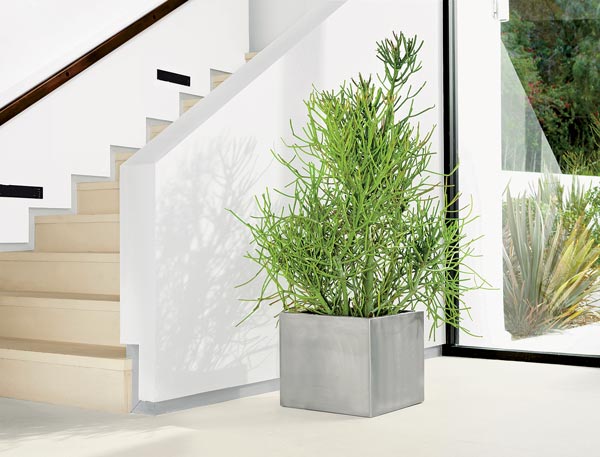
Square stainless steel planter, $399, at Room & Board. See more photos in our gallery below.
Q: I love how sculptural and sexy houseplants can look in modern environments. My plants seem fussy and old-fashioned in comparison, and I have trouble keeping them alive. How can I get a cooler, more thriving plant thing going?
A: Thinking green is always a good idea, but you need to be realistic about the physical limitations of your space and the needs of plants. “A lot of people will be drawn to the look of certain plants, take them home, and kill them,” says Todd Pope, a division manager for the design group at Green View and the lead designer for Macy’s splashy annual flower show on State Street. “Most Chicago interiors don’t have the light or the humidity needed by a lot of varieties.”
Among hardy species that don’t mind low light, he recommends split-leaf philodendron, sansevieria, and echeveria. Designer and TV personality Frank Fontana, who devoted a chapter of his latest book, Frank Fontana’s Dirty Little Secrets of Design, to outdoor design, suggests Chinese evergreens, lucky bamboo, and peace lilies, all “super easy to maintain and unique and on-trend for today’s modern interiors.” To create humidity for plants, Pope puts gravel-filled trays of water underneath pots, keeping the water level below the bottoms of the pots. This also helps reduce insect and disease issues, as critters tend to be attracted to arid environments.
You can even make what Pope calls “granny plants” look good in the millennial home by changing their presentation. “We’re way past the parlor palm stuck in the corner of the room, where it’s forgotten,” he says. “Find ways to make plants the focal points and art pieces of your environment by using totally unexpected players like dwarf varieties or contrasting-colored ghost ferns that will be really surprising.”
Bridget Johnson, the creative director of the special-events-planning firm Kehoe Designs, considers the shape of the leaf and how it will relate to the furniture and design of the interiors she creates. “Palm trees and ficus plants have very distinctive leaf shapes and can play an important role in conveying a mood,” she says.
Shift those ferns down from the tops of bookcases (who wants to climb up there to water them anyway?) to sleek, contemporary plant stands and it’s a whole new game, says Susan Randstrom Bruck, a sales associate at Pasquesi Home and Gardens. And remember that one big, lush plant can have more impact than two or three dinky ones. “Foxtail ferns have a great dramatic form and can grow to four feet in diameter and height,” she says, “so the fronds can really drape down when you put one on a pedestal in a room.”
Grouping several of one plant, or different varieties of like-minded plants, turns them into more active elements in a room and avoids a cluttered effect. Pope says he was at a party recently where everyone commented on what appeared to be a large pile of rocks in a concrete tray on a table. Those “rocks” were in fact one of his favorite succulents, lithops (also known as living stones), which have a smooth, sculptural appearance that could understandably trompe the most discerning of l’oeils. A single stem can sing in a Mapplethorpe photo, but Bruck thinks less is a bore when it comes to orchids, one of her favorites; she loves potting up three or more in low horizontal containers for maximum wow. “They’ll give you plenty of long-lasting, colorful blooms,” she says, “especially those of the Phalaenopsis or Dendrobium genera.”
Or try vertical arrangements. “When you’re short on floor space, take advantage of the height of your rooms by using a funky old wooden ladder or a wall-mounted magazine rack for a vertical garden,” Fontana suggests. Whole panels of plants, available in a range of sizes, are coming into vogue as architectural elements (especially in large public and commercial spaces), but for domestic situations be sure to consider the weight of the soil and the somewhat tricky maintenance issues. Soil-less mix-ins such as Perlite retain water and can help lighten the load.
As for pots, the scale of a plant should dictate the size of its container. Tall, angular mother-in-law’s tongues can look strange in shallow pots; moss gardens and sedum arrangements are more suited to low-profile pans or trays. Fontana’s rule of thumb is to allow a good two to three inches of soil around the root ball, and even then you’ll still eventually have to switch out the vessel for a bigger one. “Plants grow more slowly inside than outside,” says Pope, “but they will inevitably outgrow their pots. Choosing houseplants is not like buying a vase to stick on a shelf forever, so don’t think of them as static landscapes.”
Finally, don’t be afraid to think outside the pot. Lisa Kelly, cofounder of PrairieMod, a website and online retailer, loves to use unconventional containers such as the space-age Retro Bullet planters on tripod stands from Hip Haven and tubular FlowerBox vertical planters that hang on the wall. Kehoe’s Johnson likes to update classic urn-shaped vessels by painting them with surprising high-gloss fashion colors and to place square brushed-steel containers on risers so there is space underneath. “Hollowed-out logs and faux concrete boxes make great containers. Just make sure there’s a solid liner so that water and soil won’t seep out,” says Pope. “You’re limited only by your imagination.”
Photography Leonard Gertz
Have a design or renovation question? Just drop us a note at chicagohome@chicagomag.com and we‚ll do our best to answer it. Sorry, we cannot take questions by phone, or guarantee individual responses.


